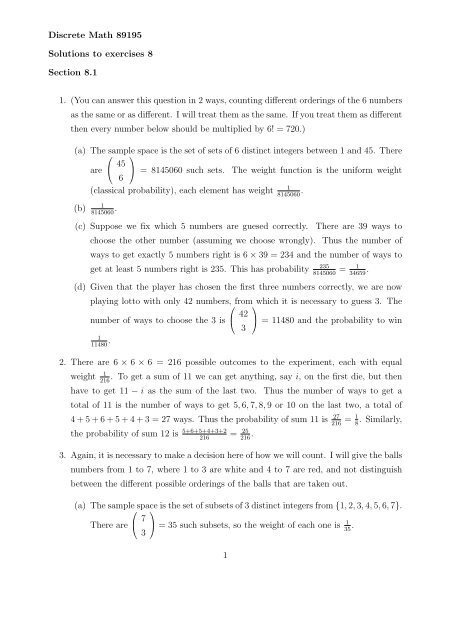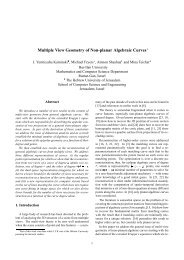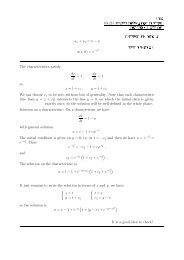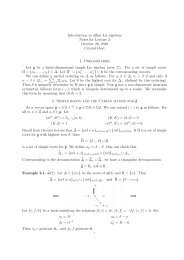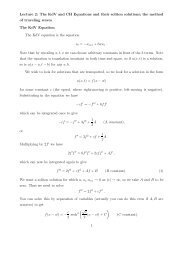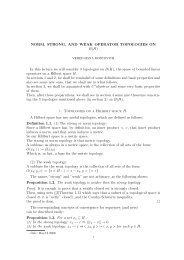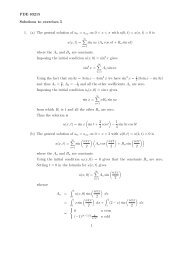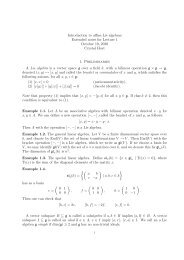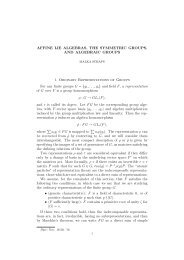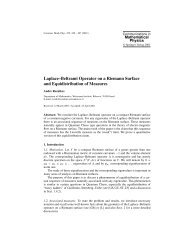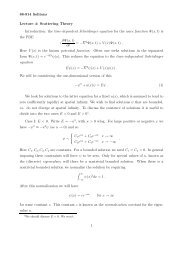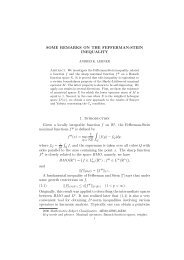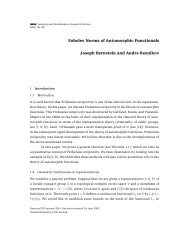Discrete Math 89195 Solutions to exercises 8 Section 8.1 1. (You ...
Discrete Math 89195 Solutions to exercises 8 Section 8.1 1. (You ...
Discrete Math 89195 Solutions to exercises 8 Section 8.1 1. (You ...
You also want an ePaper? Increase the reach of your titles
YUMPU automatically turns print PDFs into web optimized ePapers that Google loves.
(b) The number of ways <strong>to</strong> do this is 6 × 3 = 18, so the probability is 18 . (6 is the35number of ways <strong>to</strong> choose the 2 red balls out of 4, 3 is the number of ways <strong>to</strong>choose the 1 white ball out of 3.)4. I incorrectly read this question as saying the pack is divided in<strong>to</strong> 2 piles of26 cards each. This is not the correct reading of the question! I leave it <strong>to</strong>the reader <strong>to</strong> do it properly.(a) The sample space is the set of subsets of 26 distinct integers from 1 <strong>to</strong> 52. Each⎛element has the same weight. There are ⎝ 52⎞⎠ ≈ 5 × 10 14 such subsets.26(b) Need <strong>to</strong> choose the 13 (out of 26) black cards and the 13 (out of 26) red cards⎛<strong>to</strong> comprise one half. The number of ways <strong>to</strong> do this is ⎝ 26⎞2⎠ , and thus the13⎛⎝ 26⎞2⎠13relevant probability is ⎛⎝ 52⎞ = 26!4 ≈ 0.21852!(13!) 4⎠265. The number of different possibilities for the structure of the family is 2 10 (now weare taking in<strong>to</strong> account order), each having probability 1 . The number of structures⎛2 10with r boys is ⎝ 10⎞⎛⎠, so the probability of r boys is 1 ⎝ 10⎞⎠.2r10 r⎛(a) Probability of 5 boys is 1 ⎝ 102 10 5(b) Probability of 3 <strong>to</strong> 8 boys is⎞⎠ = 63256 .⎛⎛1⎝⎝ 10⎞ ⎛⎠ + ⎝ 10⎞ ⎛⎠ + ⎝ 10⎞ ⎛⎠ + ⎝ 10⎞ ⎛⎠ + ⎝ 10⎞ ⎛⎠ + ⎝ 10⎞⎞⎠⎠2 10 3 4 5 6 7 8= 1957(120 + 210 + 252 + 210 + 120 + 45) =210 1024Note that is much easier <strong>to</strong> do the probability of “not 3 <strong>to</strong> 8 boys”. This is⎛⎛1⎝⎝ 10⎞ ⎛⎠ + ⎝ 10⎞ ⎛⎠ + ⎝ 10⎞ ⎛⎠ + ⎝ 10⎞ ⎛⎠ + ⎝ 10⎞⎞⎠⎠2 10 0 1 2 9 10= 167(1 + 10 + 45 + 10 + 1) =210 10242
<strong>Section</strong> 8.3<strong>1.</strong> Two ways of doing it:First way (using the distribution): This random variable has the following values andprobabilities:1P(X = r)32and thus the expectation is5∑E[X] = rP(X = r) = 0× 1r=032 +1× 5 32r 0 1 2 3 4 55321032103253213210 10+2× +3×32 32 +4× 5 32 +5× 1 32 = 8032 = 5 2Second way (using linearity of expectation): Define random variables X 1 , X 2 , X 3 , X 4 , X 5by⎧⎨ 0 if the i th term in the series is 0X i =⎩ 1 if the i th term in the series is 1Then X = X 1 + X 2 + X 3 + X 4 + X 5 . Each of the X i has equal probability <strong>to</strong> be 0 or1 and thus expectation 1 2 . Using linearity of expectation, E[X] = 5 × 1 2 = 5 2 .2. There are 3 5 = 243 such sequences.(a) As in the last question, define X i (i = 1, 2, 3, 4, 5) <strong>to</strong> be 1 if there is a 1 in the ithplace of the sequence. Then X = X 1 + X 2 + X 3 + X 4 + X 5 is the <strong>to</strong>tal numberof 1’s. E[X i ] = 1 and E[X] = 5 . (<strong>You</strong> can get this also from the distribution of3 3X, which is binomial with parameters 5, <strong>1.</strong>)3(b) This question is not well-defined as it stands — it is necessary <strong>to</strong> decide whetherthe sequence “111” should be counted once or twice, whether “1111” should becounted once, twice or thrice etc. If we decide <strong>to</strong> count “111” twice etc. thenwe can do the following. Let Y 1 be 1 if there is a 11 starting in place 1 and 0otherwise, Y 2 be 1 if there is a 11 starting in place 2 and 0 otherwise etc. Thenthe number of sequences “11” is then Y = Y 1 + Y 2 + Y 3 + Y 4 . E[Y i ] = 1 9E[Y ] = 4 9 .This is the easy way <strong>to</strong> do the question - If we decide <strong>to</strong> only count “111” asone sequence, then we define Z 1 , Z 2 , Z 3 <strong>to</strong> be the indica<strong>to</strong>rs of the events thata sequence “111” starts at positions 1,2,3 respectively, V 1 , V 2 <strong>to</strong> be indica<strong>to</strong>rs ofthe events that a sequence “1111” starts at positions 1,2 respectively and W <strong>to</strong>be the indica<strong>to</strong>r of the events that the sequence is “11111”. ThenY = (Y 1 + Y 2 + Y 3 + Y 4 ) − (Z 1 + Z 2 + Z 3 ) + (V 1 + V 2 ) − W4and
(this is inclusion-exclusion) andE[Y ] = 4 1 9 − 3 1 27 + 2 1 81 − 1243 = 862433. (a) The winnings in the game is a random variable with the following distribution:r 1 1 2P(X = r)16161316141615161616And thus the expectation of the winnings isE[X] = ∑ rrP (X = r) = 1 6(1 + 1 2 + 1 3 + 1 4 + 1 5 + 1 )= 1476 360(b) The winnings in the game is now a random variable with the following distribution:r12P(X = r)13613236143361543616536And thus the expectation of the winnings isE[X] = 1 36176361853619436110336111236( 12 + 2 3 + 3 4 + 4 5 + 5 6 + 6 7 + 5 8 + 4 9 + 3 10 + 2 11 + 1 12)112136= 167477997920 ≈ 0.16814. The probability of i, j being switched is (since there are n ways <strong>to</strong> chose π(i) andn(n−1)n − 1 remaining ways <strong>to</strong> chose π(j)). Defining the random variable f i,j as inidicated,we therefore haveE[f i,j ] =1n(n − 1)The <strong>to</strong>tal number of “switches” is the sum of all the f i,j . And thus its expectation is( n2)Suprisingly low! And independent of n!1n(n − 1) = 1 25


